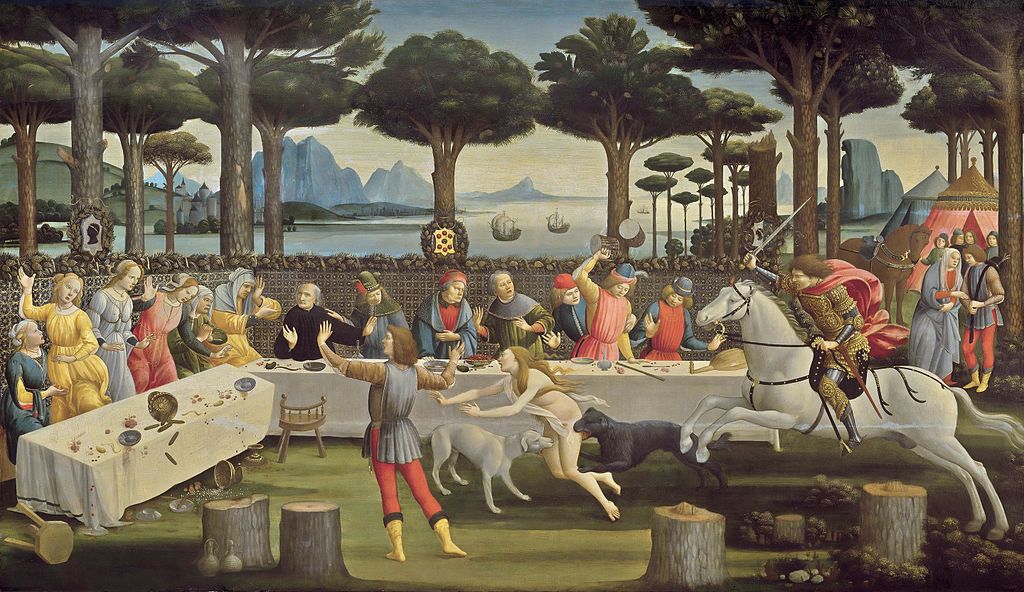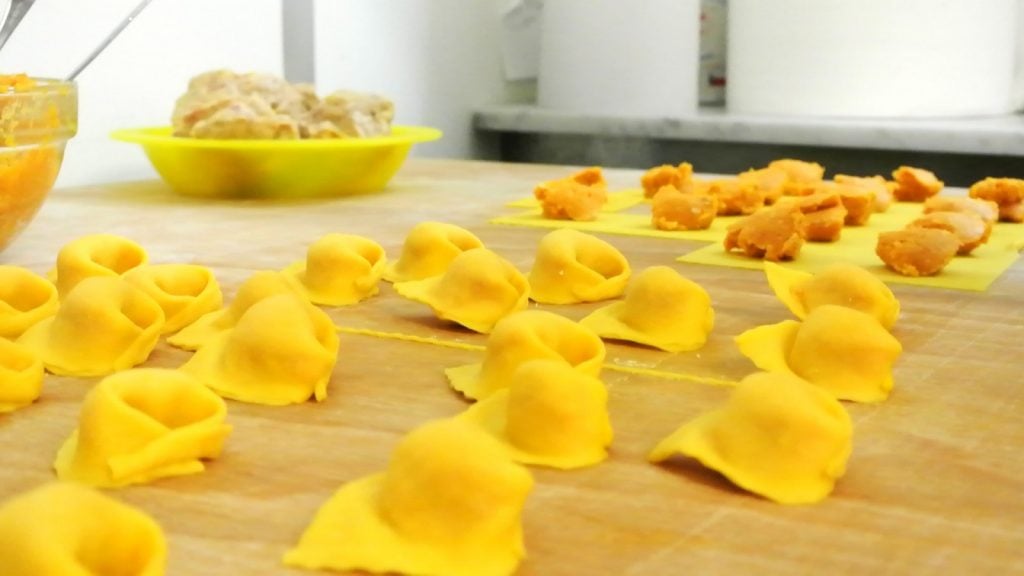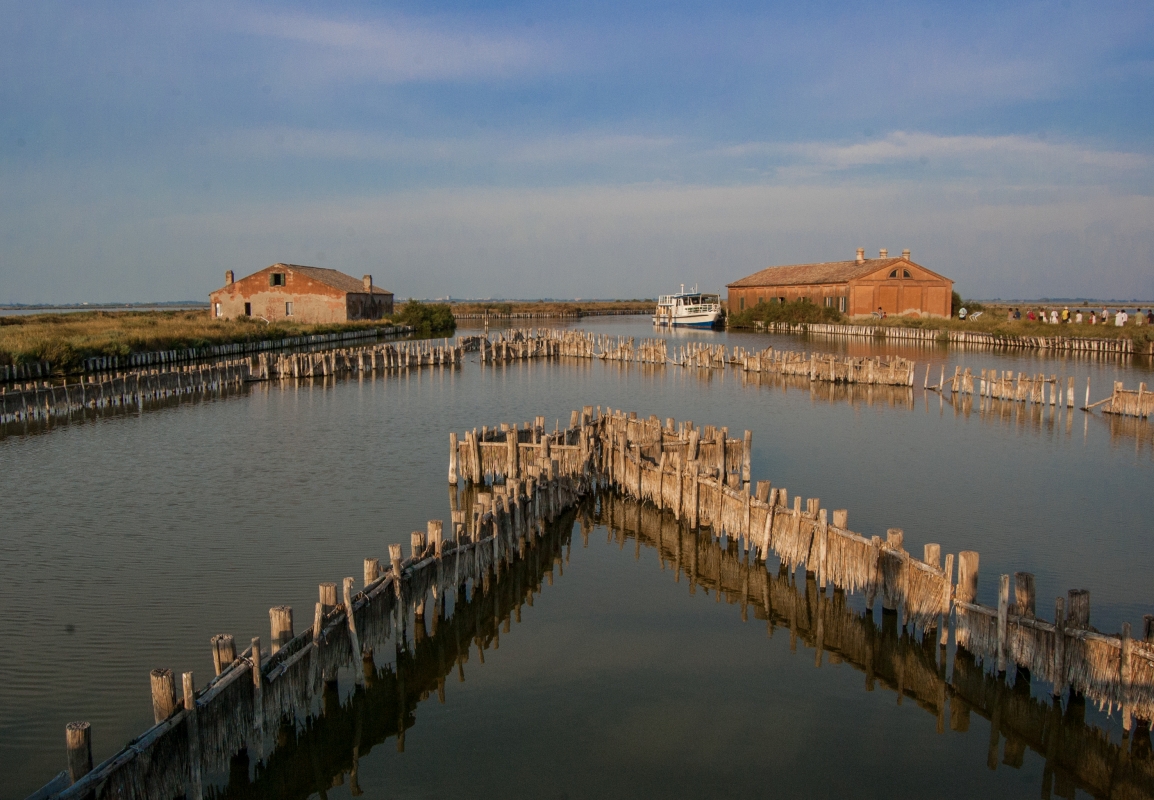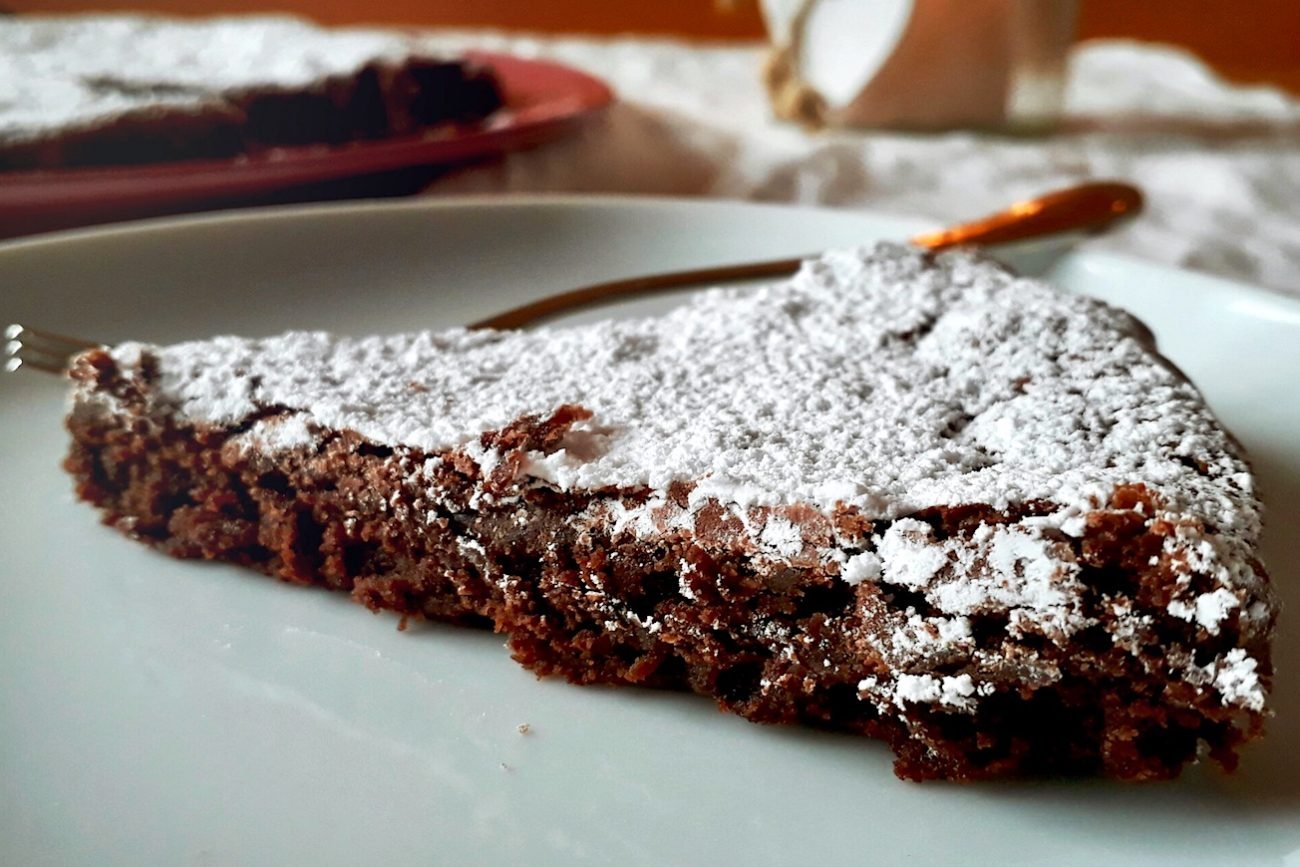Ferrara boasts an extraordinary quantity of typical dishes, a symptom of how culinary art has always had great importance in the cultural tradition of this city, an importance mainly due to the presence of the Este House which has deeply marked its gastronomic habits. During the Renaissance, Ferrara was a worldly and aristocratic place. Among the richest courts of Europe, refuge of great intellectuals such as Boiardo, Tasso and Ariosto, Ferrara in the 15th and 16th centuries was considered one of the most illustrious and famous cities in Europe.
The ceremonial life at the Este court provided for sumptuous banquets with all kind of dishes and for which the artisans of the near city of Faenza were involved in the fabrication of special art pottery.

Botticelli – Banquet in the woods, Ph. Prado Museum Madrid via Wikipedia
But Ferrara was also the place where for the first time the habits of the diners became a norm. The Este’s Galateo, among the many prescriptions, foresaw that the meat was no longer torn with the hands, as the use of barbarians, but that it was served already cut to the guests. The art of the “Scalco” was born, the servant assigned to cut and serve the meat; famous was the episode of the butler from Ferrara Cristoforo di Messisbugo, who knew how to serve the meat so well to Emperor Charles V that he even gave him the title of Conte Palatino.
In short, Ferrara was one of the places where, thanks to the presence of a rich court, of advanced trades and of an extremely fertile surrounding territory, the bases of Italian Cuisine were developed. The typical dishes of Ferrara then bring with them this scent of ancient preparations and combinations of flavors that return the taste of Renaissance noble courts, and in which sweet and savory, spices and local fruits, contribute to the creation of flavors lost in the pages of history.
https://youtu.be/5M535Wd0T0I
But Ferrara is also the place where it is still possible to trace the origin of the dishes, the geographical and social reasons of their existence in a path that reconciles the enjoyment of the palate and the mind. From this point of view, therefore, anyone who wants to approach the Ferrara’s kitchen, will find that the flavors he expresses have not changed since the period when the Este House reigned here.
Cappellacci

Handmade Cappellacci – Ph. Fabio Duma
It is one of the most famous and renowned recipes of Emilia Romagna and it is said that their shape recalls the peasants’ hat, from which moreover they take their name.
Obviously made of puff pastry, they are similar to tortellini but in a large version. The first signs of the “Cappellacci di Zucca Ferraresi” are found in the Renaissance recipe books of the Scalchi, a guild of special gastronomic servants, where we find the first references to “Tortelli di Zucca con il Butirro”. In fact, one of the first recipes of this dish dates back to 1584, when the Scalco Giambattista Rossetti mentioned it in one of his recipes.
The original ingredients are the same as the current recipe were it not for the addition of some spices, such as ginger and pepper, now fallen into disuse but at the time of the Este’s court particularly widespread. The pumpkin usually used is the named “Violina”, a variety that owes its name to the elongated shape similar to that of the musical instrument. After a steaming or baking, the pumpkin pulp is mixed with Parmigiano Reggiano or Grana Padano, eggs, breadcrumbs, salt, pepper, and nutmeg; the filling is thus ready to be wrapped in the hand-made dough.
Pasticcio
The “Pasticcio di Maccheroni” is a typical Ferrara dish from the Carnival period. Also, the Pasticcio is a recipe of ancient tradition, and, as others Ferrara’s recipes, it dates back to the ancient banquets of the Este Family. It consists of a short pastry wrapping, on which are placed the macaroni seasoned with meat sauce, béchamel, and mushrooms; as a result, its taste is a combination of sweet and savory.
Because of its complexity of execution, it has always been considered a prestigious dish, which often featured in high-level lunches and, more recently, in family lunches during holidays. According to some, the mess of Macaroni is not a recipe from Ferrara, but it would instead be an imported dish from the Neapolitan court, where it was particularly widespread. When in fact, Eleonor of Napless, daughter of Ferdinand I of Naples, went in marriage to Ercole I d’Este in 1473, the cultural exchanges between the two seigniories became more dense, which led some of the Neapolitan court’s gastronomic preparations directly on the tables of Ferrara banquets.
Salama da Sugo
The Salama da Sugo it is, among the Ferrara’s gastronomic specialties, the one that more than others has survived unchanged over the centuries and that is still prepared according to the ancient, rigid ritual. This traditional dish, which is not a salami, is a mixture of minced pork with red wine, salt, black pepper, nutmeg, cinnamon and cloves and other secret ingredients that no artisan of taste will ever be willing to reveal.
It is seasoned for about a year and requires a long boiling in water, close in a cloth so that it does not split and hang so that it does not touch the pot. To eat it, it is uncovered and you dig the soft and tasty dough with a spoon, it is forbidden by the tradition to use the knife. It is usually served with mashed potatoes, but it is much more “Estense” (potatoes came only later, with the discovery of America) to associate it with the typical pumpkin puree, which gives the whole a sweet-savory contrast of ancient tradition.
An entire poem was also dedicated to her, the “Salameide” by Antonio Frizzi (1772), from which it is clear that Salama is mainly made up of liver, not meat.
Tagliatelle cake
The Tagliatelle cake is a typical dessert of Emilia-Romagna tradition whose recipe dates back to the Renaissance. It is well known in the countries of the Tuscan-Emilian Apennines, but it is also very widespread in the Ferrara area and even in the province of Mantua (where it is prepared without the shortcrust shell). It is an ancient cake and it is said that the “fine noodles” that decorate the surface are nothing more than a tribute that was made to the blonde hair of Lucrezia Borgia, the was the Lady of Ferrara for almost twenty years. The base of shortcrust pastry contains a filling of almonds and honey, while the upper decoration, with nests of fresh tagliatelle of puff pastry, made with eggs and flour, and when cooked in the oven becomes particularly crisp. It is usually served with almond liqueur.
Tenerina
The Tenerina Cake is one of the most famous and appreciated Emilia-Romagna desserts but the land that gave birth to this delicious cake is the city of Ferrara. From a point of view of culinary suggestions, it is sweet of French derivation, in particular, it is united to the “Moelleux au chocolat”.
Known since 1900 as “Montenegrin Cake” or “Queen of Montenegro Pie”, it seems to have been originally prepared in homage to Elena Petrovich of Montenegro, the bride of the then King of Italy Vittorio Emanuele III. The people of Ferrara instead named it “Tacolenta cake”, for its internal consistency almost sticky that melts in the mouth, delighting the palate. Served with a sprinkling of powdered sugar or with mascarpone, this splendid and tasty dessert, has a crispy exterior that reveals inside a heart of soft melted chocolate still semi-liquid.
Panpepato
The Panpepato is a dessert that the city of Ferrara shares with many areas of Central Italy.
The chronicles narrate that in 1660 the nuns of the Corpus Domini monastery of Ferrara drew inspiration from a recipe by the famous Estense cook Cristoforo da Messisbugo, creating a dessert to be sent to the great personalities of the time.
One of its main ingredients is cocoa, which at the time had just arrived in Europe from the New World and was considered a luxury good for a few. Zuccotto-shaped and embellished with almonds, hazelnuts, candied fruits and spices perfumed for Renaissance use, derives its name from the ancient name “Pan del Papa” [Bread of the Pope], precisely because it is a rich and sumptuous dessert.
Today you can find it with the name of Panpepato or Panpapato, and it is the typical dessert of Christmas, of parties and that best represents the richness and refinement of Ferrara. Its intense flavor and spicy scent recall both the flavors of the territory and the intense aromas coming from the Far East.
Clams
In the Po Delta area, aquaculture has always played a major role, so much so that it has taken over the last twenty years, a significant dimension also at National and European level. Its historical origins can be traced back to the turn of the seventeenth and nineteenth centuries when the production system of the Po Delta was born and developed, closely controlled by man. In particular, since its formation, the Ferrara territory of Goro has been inhabited by fishermen dedicated to exploiting local natural resources. Among these, the fishing of clams, mussels, and other native fish species have been the main source of food subsistence for many centuries, whose soft and fleshy bodies are well suited to different preparations in the kitchen.
Here there is little space for creativity, it is the simplest cooking that exalts the best clam taste: in a hot pan with oil, crushed garlic and a handful of parsley, with a very quick cooking and keeping the water released from mollusks.
Comacchio’s Eels

“Lavoriero” the traditional Comacchio’s fishnet for Eels – Ph. Monuwanda
Here we are again within the Po Delta area, whose people have been dedicated to fishing and eels processing over the centuries.
These fish are born in the ocean and, around the age of three, swim towards the delta of some great river where they spend most of their lives. Around the age of eight/ten the eels return to the ocean to go mating in the Sargassi’s Sea, where they lay their eggs before they die. In order not to allow the eels fattened by the years passed by the river to slip into the sea, the fishermen of Comacchio for centuries installed complex systems of traps made of reeds and called “Lavorieri”, which are located in strategic points of the Delta, where the lukewarm sea water saturated with oxygen breaks into the lagoon. Tradition has it that eels are extracted from traps during frosty nights, in absolute silence and with a full moon, as artificial light is not recommended. According to some, there would be no less than forty-eight different dishes based on the eel, ranging from the delicate risotto to the grill on which the eel releases all its intense aroma and that makes it a gastronomic ritual that is impossible to resist. Especially popular are the eel females, larger and longer, which are commonly called “Capitone” and whose preparation is a typical national dish of the Christmas period. Lastly, we recommend two more famous dishes based on eels deriving from the so-called popular poor cooking, the “brodetto” and “risotto“. In ancient time the slices of the fish, considered valuable parts, were exported out of the fishing grounds, so the inhabitants could only have the heads. In popular gastronomy, these became the raw material for a famous regional dish, the “brodetto” which, besides being consumed as it was, could be used as a base for the preparation of fantastic risottos.
Wines of the Sands
Also, in this case, the Ferrara viticulture is affected by the Este period. The grafting of the so-called Wines of the Sands in the Ferrara’s Valleys was most likely in 1528 when Ercole II Duke of Este married Renata di Francia, daughter of Louis XII. The young French royal brought in dowry a vine of the Côte d’Or of Burgundy, which found the perfect habitat in the areas of the Sand Dunes, among the holm oaks and delta bushes. The particularly humid, foggy and static environment, the strongly salty air and the land, the constant proximity of the sea and the lack of fresh water have contributed, over the centuries, to the formation of a grape with a strong character, perfect for dishes meat and fish from these areas.
Author

Walter Manni
Explorer and Adventurer: loves sailing the oceans, climbing the highest mountains and surfing on the waves of the web
